Foot of the Month: Quilted Vest with Zippered Pockets
If you love to sew from scratch and learn new techniques, you will enjoy this sporty quilted vest project, made using a commercial pattern. These instructions include a pattern hack for making non-bulky and neatly stitched zippered front pockets. Featured sample is sewn in a size for boys, but you could use the same general guidelines for the men’s size. Polish up your pocket making skills with this project and your finished garment will rival ready to wear! Since zippers are prominent in this project our featured Foot of the Month is the new Narrow Zipper Foot. This foot is ideal for stitching both sport style and regular zippers. You can substitute with the standard sliding zipper foot as well.
Materials and Supplies:
- Brother Sewing Machine or Brother Sewing and Embroidery Machine for added embroidery
- Brother Walking foot or Dual Feed Foot
for quilting vest
Note: One of these feet may be included with your Brother machine.
- SA208 Brother Narrow Zipper Foot
or SA161 Brother Adjustable Zipper Foot
for sewing zippered pockets and center front zipper - Vest pattern with zippered pockets in front seams, plus fabric and basic sewing notions as indicated on the pattern envelope, including appropriate machine needle and sewing thread for construction. See pattern in Figure #1 below.
Note: Sample vest is made from lightweight grey denim, quilted with thin fleece and lined with flannel shirting fabric.
- For the pocket technique presented here you will need to cut the four pocket pieces using lining weight fabric. Purchase zippers as described below.
- For zippered front pockets purchase two standard polyester coil zippers to match jacket fabric, having zippers measure at least 2-inches longer than pattern requires. Two 7-inch zippers were used in this example.
Note: A separating zipper is needed for the center front. Sample vest features a synthetic separating sport style zipper. If you can’t find the precise length you can purchase a longer zipper and shorten it from the top edge. There are several methods for doing this. Use your favorite method or follow the tips presented at the end of these instructions.
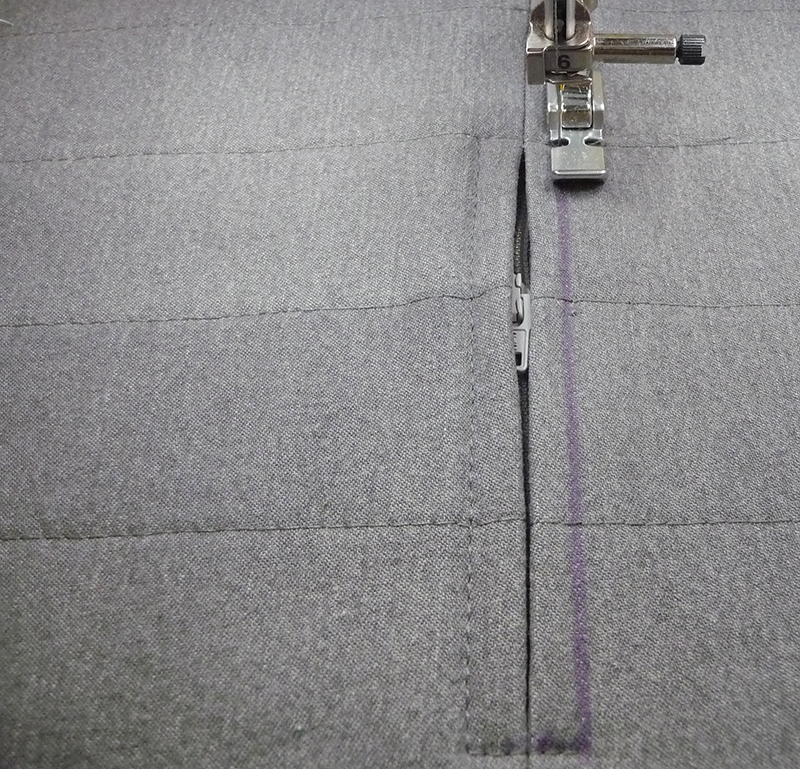
- Zipper foot featured in these instructions is SA208 Brother Narrow Zipper Foot. To use left side of foot set needle position to zero. To use right side of foot set needle position to 7.0
General information for making this vest:
- Vest is based on featured pattern shown in Figure #1. Please take a few minutes to read through these instructions before beginning. Refer to pattern for general cutting and sewing instructions. Follow the pattern hack presented here for sewing the zippered front pockets. You’ll find that this pocket is easy to do when you work step-by-step, using the instructions and photos provided here. Consider using the pocket technique shown here for similar patterns with pockets inserted in front seams.
 Figure #1[/caption]
Figure #1[/caption]
- Vest pattern used for this project: Simplicity 1329 View A Featured pattern is a product of Simplicity Pattern Company Inc. Brother International Corporation makes no representations or warranties regarding such products.
Creating the Quilted Vest
- Cut main pattern pieces from fabric, thin fleece, and lining. Prepare for quilting by layering a piece of fleece against the wrong side of each vest piece and basting as suggested in pattern instructions.
Tip: After basting, trim excess fleece away from seam allowance to eliminate bulk and make sewing and pressing seams easier. See below:

- To quilt pieces you can choose to follow pattern instructions for quilting during construction, or quilt all pieces at beginning as featured here in these instructions, removing basting stitches when quilting is completed.
Tips for Quilting: Set straight stitch length to 3.5 and quilt by stitching horizontal lines across each piece. It’s important that each parallel line matches corresponding pattern pieces. I like to mark my first line using low tack tape and then use a quilting guide for the remaining evenly spaced lines. I chose to quilt the lines spaced 1½-inches apart. See Figure #2a, #2b, & #2c for quilting withSA196 Dual Feed Foot, MuVit™ and the SA206 Dual Feed Quilting Guide set. This set includes a guide for both left and right side of the foot.
[caption id="attachment_11115" align="aligncenter" width="800"] Figure #2a[/caption]
[caption id="attachment_11116" align="aligncenter" width="800"]
Figure #2a[/caption]
[caption id="attachment_11116" align="aligncenter" width="800"] Figure #2b[/caption]
[caption id="attachment_11117" align="aligncenter" width="800"]
Figure #2b[/caption]
[caption id="attachment_11117" align="aligncenter" width="800"] Figure #2c[/caption]
Figure #2c[/caption]
- When using a walking foot with the SA132 quilting guide, the guide is designed for use on the right side of the foot. See below:
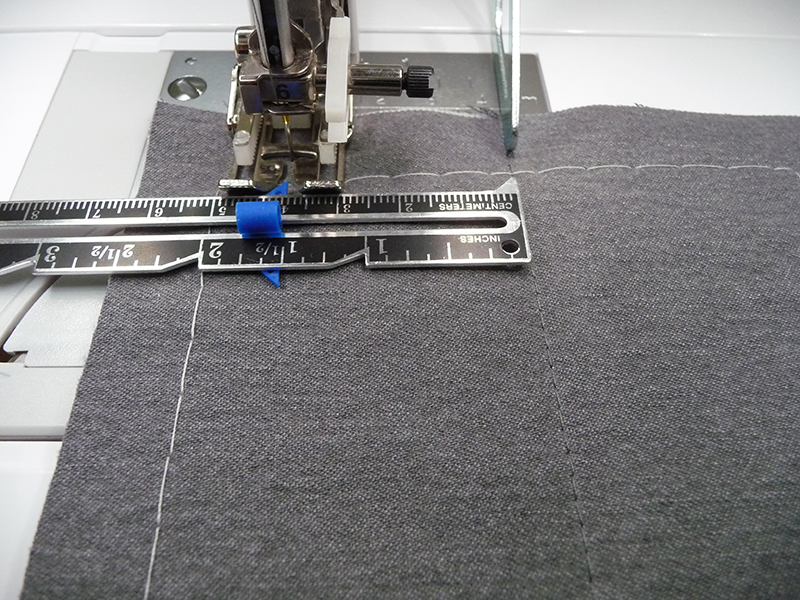
- Below is a small example of quilted front pieces shown with enhanced blue lines:

Tip: Even though the vest is lined it’s a good idea to clean finish raw edges of major seams with a serger, zigzag, or overcasting stitch before continuing. This makes it easier to handle pieces during construction.
- Now it’s time to prepare for sewing the zippered pockets using a method that is different from the original pattern instructions. This is commonly known as a “pattern hack.” Follow along step by step, using the photos as a guide. You will find this pocket style is not difficult sew and results in a nice, neat finish. For this method each pocket requires two pieces cut from lining fabric to eliminate bulk. To keep lining from showing when the pocket is zipped open cut four strips of vest fabric, having each strip measure 2-inches wide times the length of the pocket piece. Turn and press under ¼-inch along one long edge of each strip. Place a strip on each pocket lining piece with raw edges even. Attach to each pocket lining using a straight stitch along the folded edge. It’s important to clean finish the opposite raw edge of the strip with a serger, zigzag, or overcasting stitch. See Figure #3.
 Figure #3[/caption]
Figure #3[/caption]
Prepare to Sew Pocket as Follows:
- Follow pattern instructions to sew front vest piece to side front vest piece, leaving opening for front pocket. Press seam open. See opening shown in Figure #4.
 Figure #4[/caption]
Figure #4[/caption]
- Working from the wrong side, mark the opening with long pins.Place zipper over opening with top stop of zipper lined up with top opening and remaining length extending toward the bottom hem. Excess zipper gets trimmed later. See Figure #5.
 Figure #5[/caption]
Figure #5[/caption]
- Thread a hand needle with contrasting thread. Hand-baste zipper around opening, stitching only through the zipper tape and seam allowance, basting close to the zipper teeth. Use pins as a guide for starting and stopping and remove pins when finished. See photo of basted zipper below:
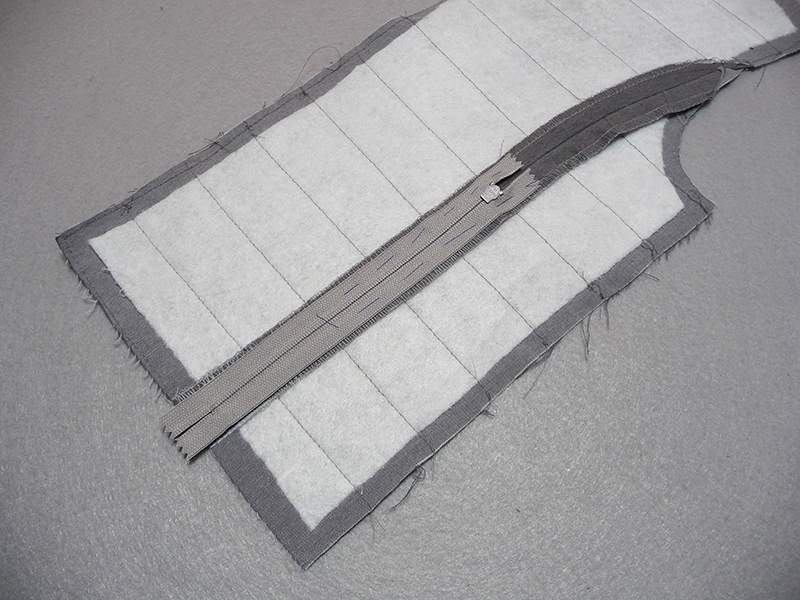
- Use a wash out marker and a ruler to mark a box for topstitching zipper, with lines marked ¼-inch from fold and stopping at the top and bottom pocket opening. See enhanced blue lines in Figure #6.
 Figure #6[/caption]
Figure #6[/caption]
- Attach zipper foot to machine. Working from the right side and stitching through all layers, stitch the first side of the zipper, stitching the side closest to the center font of vest, along with the top and bottom of the marked box. Leave the opposite side un-stitched for now. See Figure #7 with blue line showing un-stitched side of zipper.
 Figure #7[/caption]
Figure #7[/caption]
Tip: The SA208 zipper foot is very flat and narrow, making it easy to stitch this step and all remaining steps that require stitching close to the zipper. See example below:
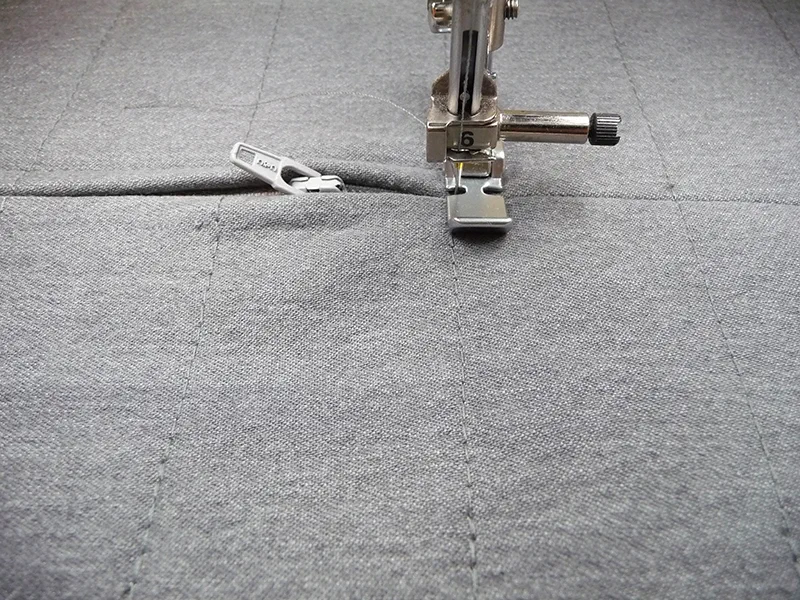
- Use the left or right side of foot as necessary. A width setting of 0.0 is used for the left side of the foot and 7.0 for the right side. It’s very important to check your setting before stitching to make certain the needle clears the foot. If you are using SA161, the Brother adjustable zipper foot, simply slide the foot into the position you need to stitch close to zipper.
- Select one of the pocket pieces. With right of pocket strip against wrong side of zipper, layer first pocket piece to align with seam allowance of front vest piece, centering it over the partially stitched box. See Figure #8.
 Figure #8[/caption]
Figure #8[/caption]
- Pin layers together, placing a pin 5/8-inch from the top and bottom of each short end to leave pocket seam allowance free. Push aside the front piece so you can stitch through just the pocket piece, zipper tape, and seam allowance. See Figure #9.
 Figure #9[/caption]
Figure #9[/caption]
- Working from the wrong side with front vest piece facing you, stitch pocket lining to seam allowance of front vest piece, beginning and ending stitching at the top and bottom pin and stitching as close to the zipper teeth as possible. Stitching line should be approximately ¼-inch from the edge. See Figure #10.
 Figure #10[/caption]
Figure #10[/caption]
Tip: Open the zipper part way to stitch without having the zipper tab interfere with stitching.
- Press pocket toward the center front. See photo below:

- Next, layer second pocket piece against wrong side of exposed zipper tape, aligning it with seam allowance of side front vest piece. See Figure #11.
 Figure #11[/caption]
Figure #11[/caption]
- Once again, pin layers together, placing a pin 5/8-inch from the top and bottom of each short end to leave pocket seam allowance free. See Figure #12.
 Figure #12[/caption]
Figure #12[/caption]
- Push aside the side front piece so you can stitch through just the pocket piece, zipper tape, and seam allowance. Working with side front vest piece facing you, stitch pocket lining to seam allowance, beginning and ending stitching at the top and bottom pin, and stitching as close to the zipper teeth as possible. See Figure #13.
 Figure #13[/caption]
Figure #13[/caption]
- Remove basting stitches. Flip and press so right sides of pocket pieces are facing. Trim excess zipper below lining, and then trim excess pocket lining so pocket edges are even at the center front. See examples below:

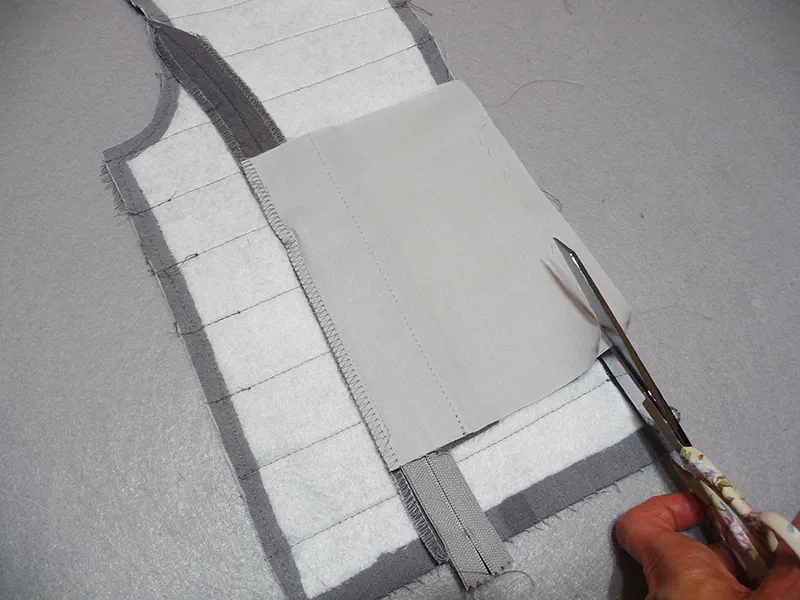
- Pin pocket layers together. Stitch 5/8-inch pocket seam, pushing away vest pieces, stitching only through pocket layers and any exposed zipper tape. The zipper foot will help you get close to the point where zipper is closed. See Figure #14.
 Figure #14[/caption]
Figure #14[/caption]
Note: It is perfectly okay to stitch through the nylon coil zipper, just remember to stitch slowly through the added bulk. The zipper stop at the bottom has been cut away but pocket seam will form a new stop.
- Working from the right side, topstitch the remaining side of the zipper, stitching the top and bottom of the marked box a second time to re-enforce the zippered opening.

- Switch to standard presser foot and clean finish raw edges of pocket with a zigzag stitch. See Figure #15.
 Figure #15[/caption]
Figure #15[/caption]
- Complete next pocket following each of the steps for two neatly finished zippered pockets. See Figure #16.
 Figure #16[/caption]
Figure #16[/caption]
- If you want to add embroidery to the left chest it would be best to do it now, before lining is in place.
- Complete construction of the vest using pattern instructions.
Note: Please see our Men’s vest companion project for this month for additional information on adding embroidery.

Tips for shortening zipper:
To use this method you will need the following supplies:- A snipping tool to snip off excess teeth along with protective eyewear to wear during the process.
- Seam sealant.
- Hand needle and thread to make a bar tack, or button sewing foot and built in machine stitch for sewing buttons. To shorten the zipper from the top, begin by marking one half of the separated zipper for the proper length, aligning the zipper with the starting and stopping point indicated in pattern instructions. Mark the second half of the zipper to match. Use a tool to carefully remove excess plastic teeth leaving 5/8-inch of excess zipper tape above marked lines. If tape frays treat with seam sealant. See Figure #17.
 Figure #17[/caption]
Figure #17[/caption]
- From this point on you want to make sure to keep zipper tab well below the top of the zipper since you have removed the top stop.
- To keep zipper from sliding off at the top of the finished vest you will need to stitch a heavy bar tack at the top edge, To sew bar tack by machine, attach button-sewing foot and select the button sewing stitch. See below:

- Position foot so stitch forms between the last two teeth at the top. Repeat the stitch three times for extra security. See Figure #18.
 Figure #18[/caption]
Figure #18[/caption]
- Treat thread tails with seam sealant and trim when dry. See Figure #19
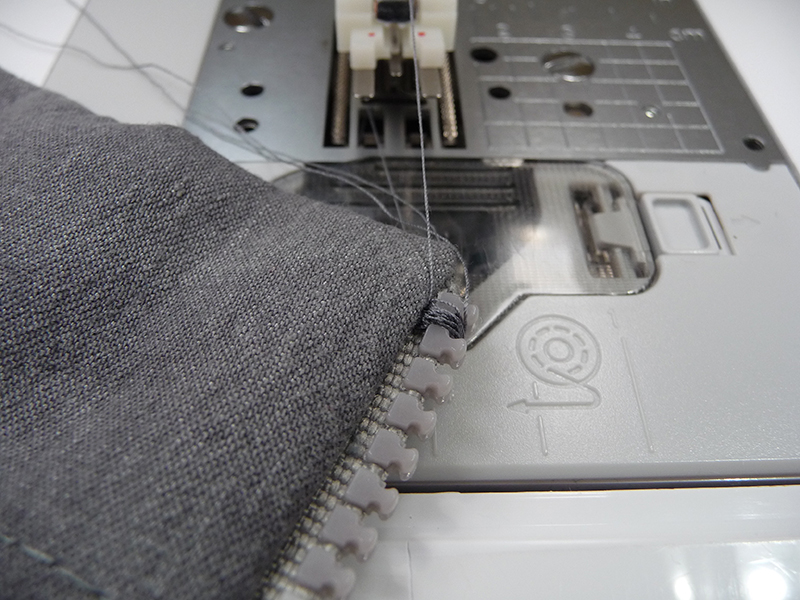 Figure #19[/caption]
Figure #19[/caption]

